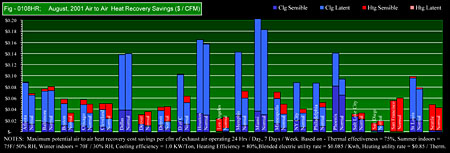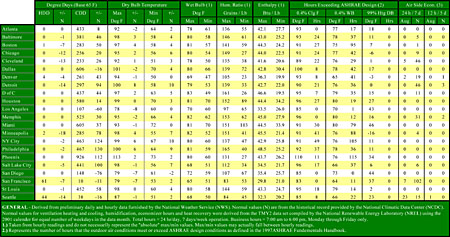

This issue focuses on the outdoor air ventilation heating and cooling energy consumption data that is provided in the table and is used to create Fig 0108V. The data represents the energy required to heat and cool the outdoor air to maintain 55? F leaving a typical coil or heat exchanger. The sensible ventilation cooling energy consumption is calculated for every hour that the outside air temperature is above 55?. Latent cooling energy is calculated for every hour that the outside air humidity ratio (Woa) is above the humidity ratio associated with the desired setpoint of 55? at saturated conditions (Wsat). The sensible heating energy is calculated for every hour that the outside air temperature is below the desired setpoint of 55?. The following formulas are utilized to generate the data.
Sensible cooling ton-hrs?cfm= [p x Cpa x K x (toa-tsp)] ? 12,000
Latent cooling ton-hrs/cfm = [p x K x Hfg x (Woa-Wsat)] ? 12,000
Sensible heating therms/cfm = [p x Cpa x K x (tsp-toa)] / 100,000
K = Conversion factor (60 min/hr);
p = Air density (lbm/cf), adjusted for altitude;
Cpa = Specific heat of air (.24 Btuh/lbm-F);
Toa = Outside air drybulb (F);
Tsp = Drybulb supply air setpoint temperature (F);
Hfg = Heat of vaporization of water (1054.8 Btuh/lbm);
Woa = Outside air humidity ratio (lbw / lba);
Wsat = Humidity ratio (lbw/lba) coinciding with tsp saturated.

Example: Chicago Hospital
The ventilation data in the report can be used to calculate utility costs associated with heating and cooling outdoor air and make comparisons to normal. For example, let's consider a hospital in Chicago with a total of 100,000 cfm of outdoor air being heated and cooled to a constant 55¿ through various air-handling systems. The central plant consists of water-cooled chillers operating at 0.75 K=kW/ton and 80% efficient gas-fired boilers. The blended electrical rate is $0.12/kWh and the cost of natural gas is $0.80/therm (Th). The utility costs associated with outdoor air ventilation for August 2001 are then:
August cooling = 100,000 cfm x 2.41 ton-hr/cfm x 0.75 kW¿ton x $0.12¿Kwh = $21,690
August heating = 100,000 cfm x 0.0 Th¿cfm x 1¿0.80 x $0.80¿Th = $0
Total for August = $21,690 + $0 = $21,690
Normal cooling = 100,000 cfm x 2.01 ton-hr/cfm x 0.75 kW/ton x $0.12/kWh = $18,090
Normal heating = 100,000 cfm x 0.0 Th/cfm x 1/0.80 x $0.80/Th = $0
Normal total = $18,540 + $0 = $18,090
It can be concluded from this comparison that outdoor air ventilation heating and cooling utility costs in Chicago were significantly higher than normal for the month of August. Note that the difference can be attributed solely to the weather since all other cost factors are constant. Next month, a similar description will be provided for humidification water consumption and utility costs. ES
